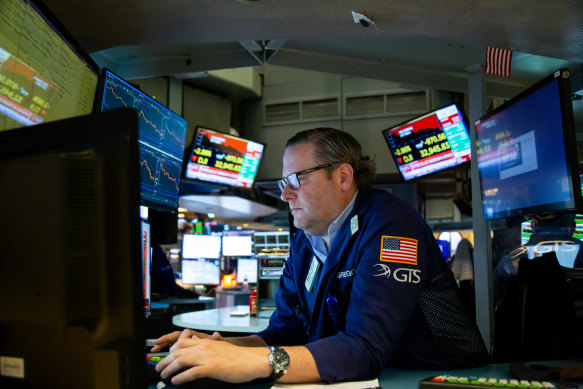ASX set to dip as Wall Street wavers
By Stan Choe
Stocks are mixed as Wall Street closes out what’s been a tough February.
The S&P 500 was 0.3 per cent higher in early-afternoon trading. The Dow Jones was down 0.3 per cent while the Nasdaq composite was 0.6 per cent higher. The Australian sharemarket is set to dip at the open with futures at 5.05am AEDT pointing to a retreat of 12 points, or 0.2 per cent, at the open. The ASX added 0.5 per cent on Tuesday.

After a strong start to the year bolstered by hopes that inflation was on the way down, Wall Street has shifted into reverse this month. A stream of data has shown inflation and the overall economy are remaining more resilient than expected. That’s forced investors to raise their forecasts for how high the Federal Reserve will take interest rates and how long it will keep them there.
High rates can drive down inflation, but they also raise the risk of a recession down the line because they slow the economy. They also hurt prices for stocks and other investments.
After earlier this year hoping that the Fed could soon pause its aggressive hikes to interest rates, and maybe even begin cutting them late this year, traders have come around to believe the Fed’s long insistence that it plans to take rates higher for longer to ensure the job is done on inflation. Many now see the Fed hiking its key overnight interest rate up to at least 5.25 per cent, if not higher, and keeping it there through the end of the year.
The Fed’s rate is currently set in a range of 4.50 per cent to 4.75 per cent after starting last year at virtually zero.
The heightened expectations for rates have sent yields jumping in the bond market this month. The yield on the 10-year Treasury rose to 3.94 per cent from 3.92 per cent late Monday. It helps set rates for mortgages and other loans that shape the economy’s health, and it’s near its highest level since November.
The two-year yield, which moves more on expectations for Fed action, rose to 4.80 per cent from 4.78 per cent. It’s near its highest level since 2007.
Such rate worries have caused the S&P 500’s gain for the year to more than halve. It was up as much as 8.9 per cent in early February, the day before a report showed that U.S. employers hired nearly a third of a million more people in January than expected.
Such strength is good news for the economy and calms fears about a recession hitting imminently. But the Fed worries it could also feed into upward pressure on inflation, which has not been coming down as quickly and as smoothly as hoped. Not only are jobs still plentiful, U.S. households also increased their spending at stores and elsewhere in January.
Now the S&P 500 is hanging onto a gain of 3.5 per cent for the year.
Reports released Tuesday didn’t show as much strength. One said that confidence among U.S. consumers unexpectedly fell in February. Another said that manufacturing in the Chicago region weakened by more than expected.
All the worries have come across a backdrop of falling earnings for big corporations. S&P 500 companies are in the midst of reporting their first decline in profits from year-earlier levels since 2020, when the pandemic was choking the economy, according to FactSet.
Most companies have already reported their results for the last three months of 2022, but several big-name retailers are still on the schedule for this week.
Among them was Target, which on Tuesday reported better profit and revenue than expected for the latest quarter. But it also echoed some other retailers in giving a cautious forecast for upcoming results as US households contend with still-high inflation. Its stock was 2.9 per cent in afternoon trade.
On the losing end was Norwegian Cruise Line. It tumbled 10.3 per cent after reporting a bigger loss for the latest quarter than expected. It also gave profit forecasts for the upcoming quarter and year that fell short of Wall Street’s.
AP
Most Viewed in Business
Source: Thanks smh.com